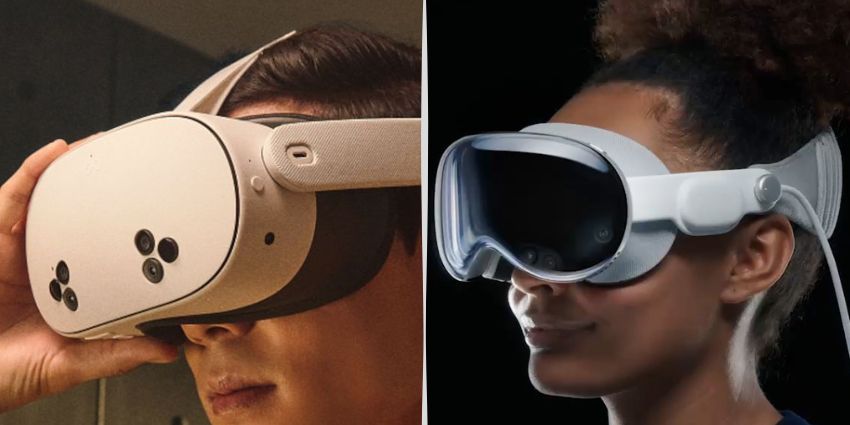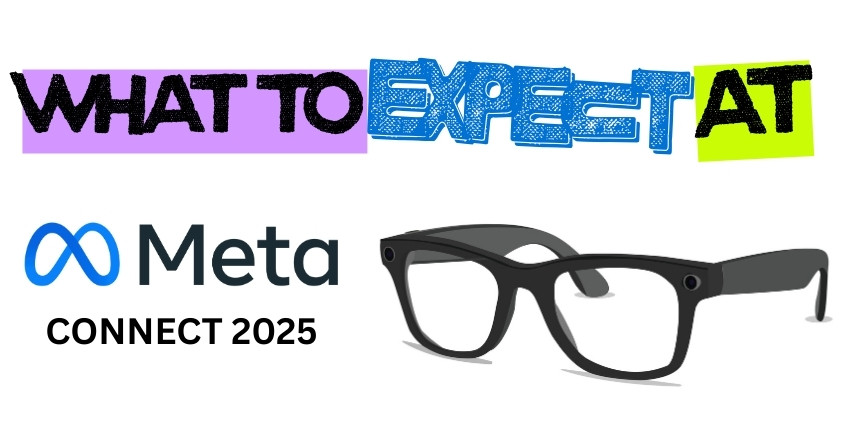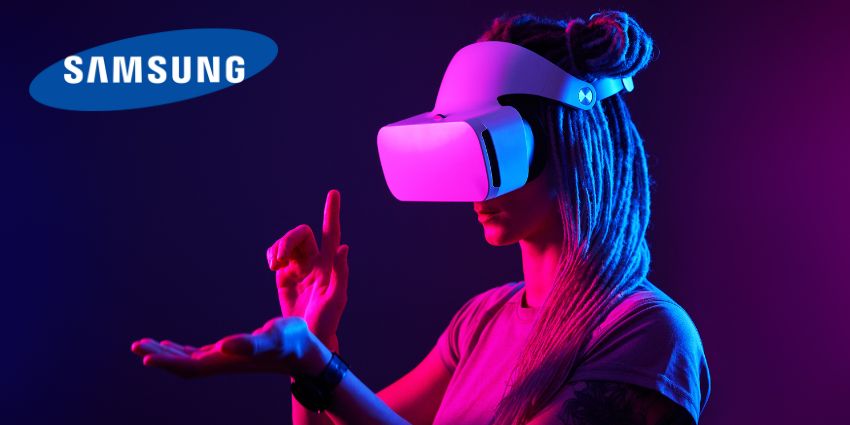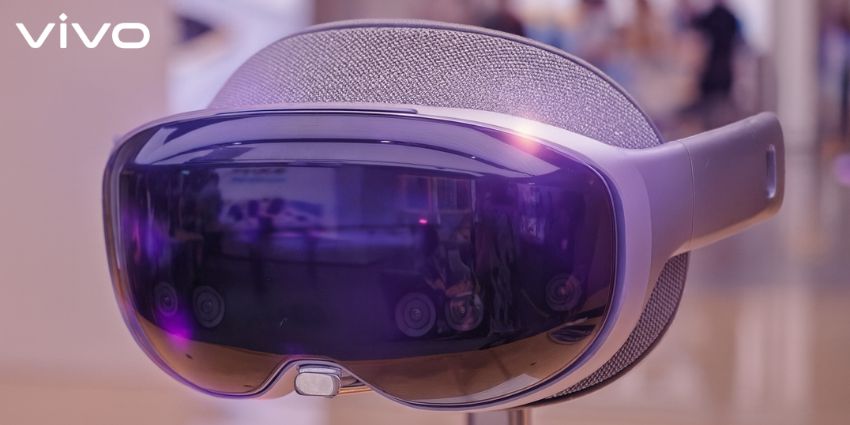The Meta Quest 3S vs the Vision Pro: Which mixed reality headset should you invest in this year? The Quest 3S, announced at the Meta Connect event in 2024, is already generating a lot of hype. Promising an even more affordable alternative to Meta’s world-leading Quest 3 headset, this device packs a serious punch despite its small price tag.
In fact, it even features the same Snapdragon processor, and full-color passthrough as its more expensive alternative. The Apple Vision Pro, Apple’s first high-end spatial computing device, is even more feature-rich, with exceptional visual fidelity, built-in eye tracking capabilities, and a set of proprietary chips offering incredible performance.
But, with a price tag almost ten times higher than the new Meta Quest 3S, it’s worth asking whether the Apple Vision Pro is really worth the extra cost.
We created this comprehensive comparison guide based on our review of the Apple Vision Pro and what we know about the Quest 3S so far to help you make the right choice.
Meta Quest 3S vs Vision Pro: The Quick Verdict
The Apple Vision Pro is a truly impressive piece of mixed reality hardware, and one of the best headsets we’ve had the opportunity to use in the last few years. It’s phenomenal for business users searching for incredible power, unique spatial computing features, and amazing visual fidelity.
The Meta Quest 3S, as a slightly pared-down version of the Quest 3, isn’t quite as game-changing, but we think it has the potential to outperform the Vision Pro in terms of sales next year. Not only is it far more affordable, but the Quest 3S is incredibly feature-rich. If you’re looking for a great mixed reality experience that won’t break the bank, the 3S is the obvious choice.
Meta Quest 3S vs Vision Pro: Overview and Specs
The success of the Meta Quest 3 over the last year, compared to the somewhat disappointing sales of the Vision Pro shows that affordability is still a major consideration for anyone investing in mixed reality. In fact, a report published earlier this year showed that around 73% of users would pick the Quest 3 over the Vision Pro – despite the Vision Pro being arguably the more powerful headset.
Since the Quest 3S delivers almost exactly the same specs as the Quest 3, at an even smaller price point, we expect it will be equally, if not more successful than the original headset.
In our view, the Vision Pro is the more powerful choice all around, and delivers a more advanced mixed reality experience. Its resolution and display are better than those offered by both the Quest 3 and Vision Pro. Plus, the spatial computing features are more advanced – there’s even integrated eye tracking, which you don’t get with the Quest 3, or the Quest 3S.
However, the Quest 3S and the Vision Pro still have some similarities – they’re both great for mixed reality, and both have incredible processing power.
Technical Specifications: Side by Side Comparison
| Meta Quest 3S | Apple Vision Pro | |
| Pricing | Starting at $299 | Starting at $3,499 |
| Lenses | Fresnel | Pancake |
| Display | LCD with 1832 x 1920 per eye resolution | OLED with 2160 x 3840 per eye resolution |
| FOV | 96 degrees horizontal and 90 degrees vertical | 100-120 degrees |
| Chipset | Qualcomm Snapdragon XR2 Gen 2 | Apple R1 and M2 chips |
| Tracking | Hand and head tracking | Head, hand, and eye tracking |
| RAM | 8GB | 16GB |
| Storage | 125GB or 256GB | 256GB, 512GB, or 1TB |
| Weight | 5145g | 600-650g |
| Battery life | Up to 2.5 hours | 2-3 hours (average) |
Quest 3S vs Vision Pro: Pricing
Let’s start this comparison with the most obvious and significant difference between the Apple Vision Pro and the Quest 3S: the price. The Meta Quest 3 was already one of the more affordable mixed reality headsets on the market, and the Quest 3S is even cheaper, starting at $299. That makes it similar in price to the early Quest 2 (despite being a lot more powerful).
The Apple Vision Pro starts at $3,499, making it one of the more expensive “premium” headsets available today. The high price tag is one of the main reasons the Apple Vision Pro has not achieved incredible sales numbers this year.
Although many enterprise users have embraced this high-end headset, the cost makes it pretty inaccessible to everyday users. It’s worth noting that it’s not just the Meta headset itself that’s cheaper either. The accessories for this headset are a lot more affordable than the optional add-ons for the Vision Pro too.
If Apple wants to ensure it can continue to compete with Meta as it introduces the Quest 3S to the market, the company might need to accelerate its plans to build a more affordable device.
Design and Ergonomics
Ultimately, the Apple Vision Pro definitely looks like a more premium headset than the Quest 3S. It’s a lot sleeker and more “futuristic” than both the Quest 3, and the cheaper Meta Quest 3S. Although some of the design features are a little unnecessary in our opinion.
For instance, the laminated glass display with ability to show your eyes to the people around you doesn’t really add much to the experience you get with this device. Like the Quest 3, the Quest 3S has a simple, plasticky design. It’s a little chunkier than the Quest 3, too, thanks to the use of Fresnel lenses instead of pancake optics.
However, the Quest 3S is still a lot more lightweight than the Apple Vision Pro (514g compared to around 600-650g). This could make it a more comfortable choice, particularly for extended use.
Both options are designed to help evenly distribute the weight of your headset over your head, to enhance comfort. However, I think the Apple Vision Pro does a better job at ensuring the device fits your face perfectly. After all, the Apple team actually tailors each device to the face of its user.
Additionally, the Apple has a couple of different strap options to choose from, such as the “Pro Dual Loop band”, which helps to reduce the risk of your headset shifting around while you’re wearing it. At this point, Meta hasn’t announced any official premium straps for the Quest 3S, although you can still customize your device with a set of prescription lenses.
Vision Pro vs Quest 3S: Displays and Audio
When we compared the Vision Pro and the Quest 3 earlier this year, we were actually quite impressed by similarity of the visuals offered by both headsets. Although the Vision Pro offered slightly crisper images, even in passthrough mode, it did have a slightly lower refresh rate than the Quest 3.
Unfortunately, the Quest 3S’s visuals aren’t quite as impressive. You do get a decent resolution of 1832 x 1920 pixels per eye, but this is nothing close to the Apple Vision Pro’s incredible 2160 x 3840 per eye resolution.
The Vision Pro also comes with pancake lenses (something also used in the Quest 3) which help to boost the sharpness and clarity of XR content. To reduce costs, however, Meta replaced these lenses with a set of simpler Fresnel lenses in the Quest 3S. That means you’re not going to get the same highly immersive experience.
The Quest 3S also has a slightly smaller field of view than the Quest 3. Plus, while the Apple Vision Pro can automatically adjust IPD for you, using built-in eye tracking, this isn’t something offered by the Quest 3S. You don’t even get the simple wheel for IPD adjustment available on the Quest 3, all you’ll have is a 3-point adjustment option.
From an audio perspective, neither headset is particularly mind-blowing, but the Apple Vision Pro offers a slightly more “polished” spatial audio experience. The sound quality is solid and clear with the Vision Pro, while the Quest 3S can struggle a little with bass and equalization.
Plus, it’s worth noting that the Vision Pro also includes six beamforming microphones for excellent collaborative experiences. The Quest 3S has one built-in microphone, but you can always connect it to an external device if necessary.
The Mixed Reality and Spatial Computing Experience
From a mixed reality perspective, the Meta Quest 3S can deliver almost exactly the same experience as the Quest 3. You still get full-color passthrough, which is a huge improvement over the black and white passthrough offered by the previous Quest 2.
However, the passthrough experience is still slightly better with the Vision Pro. The Quest 3S and the Quest 3 encounter a few issues with making the world around you seem a little fuzzier than it should be. With the Vision Pro, it feels almost like you’re not wearing a headset.
Like the Quest 3, the Quest 3S still supports hand and head tracking, ensuring you can interact with content without using controllers. However, you do still get a set of Touch Plus controllers with the Quest 3S, whereas the Apple Vision Pro doesn’t include any controllers at all.
Since Apple has focused entirely on eliminating the need for controllers with its headset, it’s probably no surprise that the hand and body tracking features are much more advanced.
Plus, it’s worth noting that the Vision Pro also has eye-tracking functionality – something you don’t get with either the Quest 3S, or the Quest 3. This means you can launch apps and interact with content in the Vision Pro using nothing but your gaze.
Quest 3S vs Vision Pro: Performance
Since the Meta Quest 3S uses the same Snapdragon Qualcomm XR2 Gen 2 processor as the Quest 3, performance is pretty much the same. With this headset, you’ll have no problem multitasking in extended reality and running a wide range of applications available through the Horizon store.
You can even use the cameras built into the Quest headset to snap pictures and create immersive videos to share with your friends. Apple Vision Pro also supports this.
In terms of software and app options, Meta’s Horizon store still offers a lot more variety than the Apple store. Although Apple has been working on expanding its range of apps and tools, it does offer a few unique experiences, like a dedicated Zoom app for immersive collaboration.
In fact, I think Apple has a slight edge overall in terms of business-focused apps for enterprise users. Meta’s Horizon portfolio might offer more options for gaming and entertainment, but Apple seems to be more focused on transforming its headset into the perfect companion for enterprise teams.
Both devices can deliver about 2-3 hours of battery life, depending on the apps you’re using. However, I do appreciate the fact that the battery is actually built into the Quest 3S. The fact that you have to keep your Vision Pro connected to an external battery pack at all times might not be a dealbreaker for some people, but it means dealing with more pesky wires and cables.
The Quest 3S vs the Apple Vision Pro: The Verdict
Ultimately, the Apple Vision Pro is the more powerful headset overall. It offers a fantastic, premium mixed-reality experience, with excellent spatial computing capabilities and much stronger visual fidelity than the Quest 3S. However, the Quest 3S is still a strong competitor.
Not only is this headset a fraction of the price of the Apple Vision Pro, but it’s also more lightweight, and still delivers an excellent all around experience. If money is no object, and you’re looking for the ultimate spatial computing headset, the Vision Pro is the obvious choice.
However, if you’re looking for a budget-friendly way to explore the world of mixed reality, the Meta Quest 3S is a fantastic alternative.







